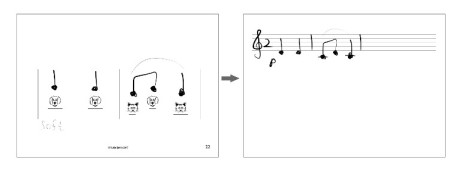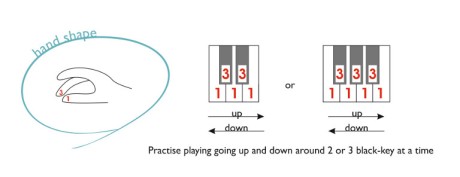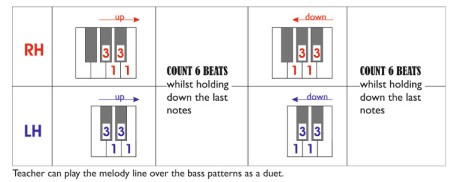As I explained here, the basic idea of this book is to help young piano beginners (aged 4 to 6) to explore ‘sound’ through singing, listening, decoding, writing, etc. I thought I’d share one example way of using this booklet in the lessons.
I took a minimalist approach for the layout of this booklet so that the learners can focus on the important information that requires their full attention. And also this gives teachers and students some room to experiment/explore elements that make music ‘musical’, such as dynamics, articulation, tempo, phrasing, creative thinking, etc.
Page 2-3
The original idea on these two pages has been explored in a form of puzzle game, which I DIY’d. Using two of 45cm x 45cm Velcro boards, I stuck the cutout images of these creatures, black-key houses and other features. A teachers can ‘mess up the order’ so that a student can put them in the right order. Multi-sensory approach such as this can help learning much more meaningful. To facilitate the memorisation of the order, I associate the images with a story, for example:
Two Black-Key House
1. Who sleeps in the kennel? A dog!
2. Elephant loves eating tree leaves, so let it sit by the tree.
3. Cats and dogs often hate each other but in this house, they’re best friends! So, they sit next to each other.
Three Black-Key House
1. Which ones are hopping creatures? Frog and grasshopper!
2. Frog loves swimming in the pond, so it sits by the pond.
3. Bee collects nectar for honey from the flowers, so he stays next to the flowers.
4. The smallest creatures sit inside the three black-key house. Ant and grasshopper sits next to each other.

As a follow-up reinforcement, I often use flashcards with images, so that the learners gradually get used to identifying a single (white) key name on the piano with the letter name. Here’re some examples:

Repeated reinforcement via visual and verbal involvement is quite important for young learners. This game exercises their brain efficiently and they usually memorise all the white key names in a couple of lessons and they can identify a single white key name on the piano without counting up from A to G!
This is one example of showing what’s provided in a couple of pages in the book (or any tutor book!) is often not enough and it usually requires supplemental work to get the most benefit. Hence, teachers would need to use their imagination to help their young students internalise what they have just learned.
Page 8
Keyboard orientation & rhythm practice by singing rhythmic syllables. Although the fingering is suggested, it can be other finger such as 3. Notes can be played any part across the keyboard; have students decide which part of the keyboard they want to play on. Encourage students to sing rhythmic syllables (green line: long, yellow line: short), not the creature names. Processing the images, Moving fingers, singing rhythms is a multi-tasking experience, which is a very much needed coordination skill for piano playing! Always draw students attention to a steady pulse as they sing and play.
Teacher can play the first bar followed by the student playing the second bar to see if they can keep a steady pulse throughout. Or teacher can play a simple accompaniment to go with the meloly to help the student establish a steady pulse. Be creative!

Page 14
Note writing. Regular practice of transcribing rhythmic notation is a good way of having the learners aware of a note value that is attached to each note. Also it’s a good way of getting used to ‘seeing’ and ‘knowing’ the meaning of the notes before students start learning to read musical notation later on. As shown on this page, above each creature you see a note, of which value is set according to the rhythmic syllable line (long or short) written under each creature. From this page onwards, ask the student to write rhythmic notation above each creature as a regular writing practice.
Page 16
Dynamics. When the learners are getting comfortable with singing and playing from the creature notation, it’s a good time to introduce another element of music, dynamics. Start with simple two contrasting loudness: forte (loud) and piano (soft or quiet). On this page shows the two identical melodic patterns. Ask to suggest a way to make an echo effect, etc. It may be a good time to explain why we call this keyboard instrument ‘piano’! For those who doesn’t know, try googling ‘Cristofori’s pianoforte’.

Page 21
Articulation & melodic shape recognition. When the learners get used to singing and playing creature notation, it’s time to start introducing another element of music; articulation (slur and staccato), which can add a flavour to the sound. Slur can be explained as ‘walky’ and staccato as ‘jumpy’. Teach how to write slur and staccato sign over or under the notes.
 Some pages can be played as one piece, a good example is page 20 & 21. Melodic shapes are very similar. Ask students to see if they can spot the difference and explain how different. Using colour pencils to mark each shape as a reminder is another good idea:
Some pages can be played as one piece, a good example is page 20 & 21. Melodic shapes are very similar. Ask students to see if they can spot the difference and explain how different. Using colour pencils to mark each shape as a reminder is another good idea:
Page 22
Composition/improvisation. When the learners feel comfortable learning pieces from this book, try encouraging them to create something or their own; perhaps in a ‘call & response’ style, or in a duet setting playing a counter-melody, etc. I’d like to share one example that occurred during the lesson with one of my 6 year-old students, although I didn’t’ intentionally set out to experiment with composing/improvisation!:
e.g1
One of my 6 year old students wanted to write her own song using creature notation, so I gave her cut-out creatures so that she can paste them on a A4 paper to create her song. The only rule I gave her was ‘not to use all the creatures, just 2 or 3 to make a simple tune’. Here is what she came up with:

And I played an accompaniment to her song like this:

e.g.2
As we played together the melody shown below, my 6 year-old student couldn’t keep the pulse, so we practised tapping the pulse as we sang the melody, then asked her to tap the beat on a single note as I played the melody. As we continued doing so, she started to responding to my playing, and than playing a counter melody to it; B– B– | CBC– |. By then she established a steady pulse in her playing. This can idea can be extended to composition exercise within a frame set by the teacher.

Introducing notes on the standard stave
With most of my students, I introduce note writing exercises as soon as they are exercised to recognise line/space notes and can understand basic rhythmic values (short & long) and . Notes are written on a single stave without a clef just to practise writing space notes and line notes, including ledge line notes so that they understand how the notes can move up and down on the stave. I wrote a blog post about it some time ago if you’re interested in reading.
By the time they get to half way through the Creature Booklet, they’re ready to start doing some transcribing exercises:

Having done a few exercises like this, my students could transcribe their own creature-notated songs into standard notation.
Have fun with creatures on the keys and always look out for what the student is captivated by on the moment and turn it into some creative activities. Be intuitive and spontaneous!



































